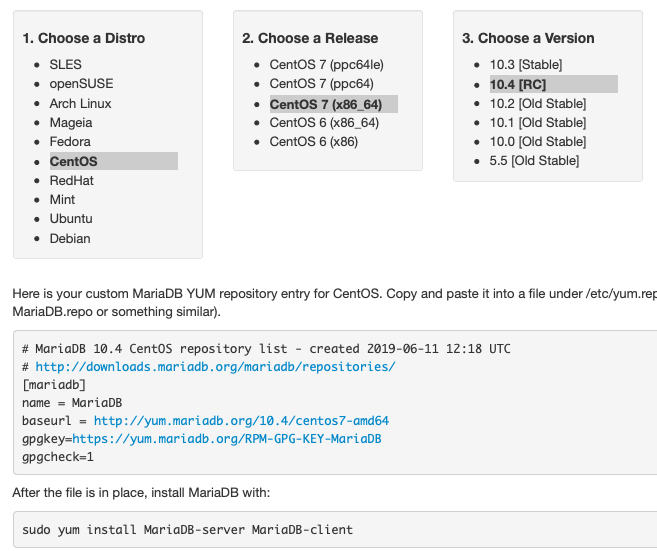Related Documents
Related Articles
Other Resources
MariaDB Galera Cluster - Binary Installation¶
MariaDB Galera Cluster is the MariaDB implementation of Galera Cluster. Binary installation packages are available for Debian-based and RPM-based distributions of Linux through the MariaDB repository (MariaDB Repository Generator).

Enabling the MariaDB Repository
In order to install MariaDB Galera Cluster through your package manager, you need to enable the MariaDB repository on your server. There are two different ways to accomplish this, depending on which Linux distribution you use.
Enabling the apt Repository
For Debian and Debian-based Linux distributions, the procedure for adding a repository requires that you first install the software properties. The package names vary depending on your distribution. For Debian, at the command-line execute the following:
# apt-get install python-software-properties
For Ubuntu or a distribution derived from Ubuntu, execute instead this command:
$ sudo apt-get install software-properties-common
If you’re use a different Debian-based distribution and neither of these lines above work, consult your distribution’s package listings for the appropriate package name.
Once you have the software properties installed, you can enable the MariaDB repository for your server.
First, add the GnuPG key for the MariaDB repository by executing the following from the command-line:
# apt-key adv --recv-keys --keyserver \
keyserver.ubuntu.com 0xcbcb082a1bb943db
Next, add the MariaDB repository to your sources list. You can do this by entering something like the following from the command-line:
# add-apt-repository 'deb https://mirror.jmu.edu/pub/mariadb/repo/version/distro release main'
You wouldn’t enter exactly the line above. You’ll have to adjust the repository address:
versionindicates the version number of MariaDB that you want to use. (e.g.,5.6).distrois the name of the Linux distribution you’re using’ (e.g.,ubuntu).releaseshould be changed to your distribution release (e.g.,wheezy).
If you don’t know which release is installed on your server, you can determine this by using the entering the following from the command-line:
$ lsb_release -a
- You should also update the local cache on the server. You can do this by entering the following:
# apt-get update
For more information on the MariaDB repository, package names and available mirrors, see the MariaDB Repository Generator.
Packages in the MariaDB repository are now available for installation through apt-get.
Enabling the yum Repository
For RPM-based distributions (e.g., CentOS and Red Hat Enterprise Linux), you can enable the MariaDB repository by creating a text file with .repo as the file extension to the /etc/yum/repos.d/ directory.
Using a simple text editor, create a new .repo file containing something like the following:
# MariaDB.repo
[mariadb]
name = MariaDB
baseurl = https://yum.mariadb.org/version/package
gpgkey = httpss://yum.mariadb.org/RPM-GPG-KEY-MariaDB
gpgcheck = 1
For the value of baseurl, you’ll have to adjust the web address:
versionshould be changed to the version of MariaDB you want to use (e.g.,5.6).packagewill have to be changed to the package name for your operating system distribution, release and architecture. For example,rhel6-amd64would reference packages for a Red Hat Enterprise Linux 6 server running on 64-bit hardware.
For more information on the repository, package names or available mirrors, see the MariaDB Repository Generator. It will generate the actual text you will need to put in your repository configuration file. In fact, by clicking through the choices presented, you can just copy the results and paste them into your configuration file without any modification.
Installing MariaDB Galera Cluster
There are three packages involved in the installation of MariaDB Galera Cluster: the MariaDB database client, a command-line tool for accessing the database; the MariaDB database server, built to include the wsrep API patch; and the Galera Replication Plugin.
For Debian-based distributions, from the command-line run the following command:
# apt-get install mariadb-client \
mariadb-galera-server \
galera
For RPM-based distributions, execute instead from the command line the following:
# yum install MariaDB-client \
MariaDB-Galera-server \
galera
Once you’ve done this, MariaDB Galera Cluster will be installed on your server. You’ll need to repeat this process for each node in your cluster.
Note
If you installed MariaDB Galera Cluster over an existing stand-alone instance of MariaDB, there are some additional steps that you’ll need to take to update your system to the new database server. For more information on this, see Migrating to Galera Cluster.
Related Documents
Related Articles
Other Resources
